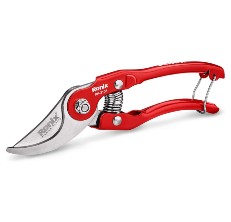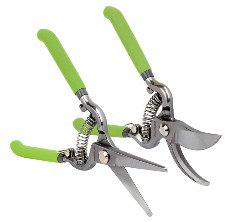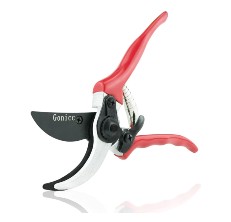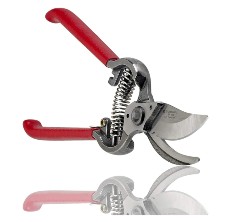- Flowers & PlantsVegetablesOur content is meticulously curated through independent research, testing, reviews, and AI-driven recommendations, all designed to present you with the finest product choices. When you make a purchase through our links, it could result in us earning a commission.
Best Bypass Pruners to Prune Effectively
 Last updated: Mar 12, 2024
Last updated: Mar 12, 2024Pruning is a practice that’s often overlooked by many, but gardeners and landscapers alike will tell you that it’s a vital task to keep your garden looking clean and healthy. Pruning involves many different tools, with some being more effective than others. Today, we’ll be taking a look at the best bypass pruners, tools that are especially useful for soft and young branches and stems of various plants.
Pruning can be done with pretty much any sharp tool, but these days, there’s a pruning tool for just about any situation, and bypass pruners shine when cutting young stems and short plants. They’re sharp, delicate, and very fun to use, and if used properly, can even make sure the flowers and plants you prune stay healthy for as long as possible. Here are the best bypass pruners you should consider adding to your garden tool set.
Show contentsComparing the Leading Bypass Pruners of 2024- Ronix Bypass Pruning Shears - Best Overall
- WORKPRO 2-Piece Pruning Shears - Runner Up
- gonicc 8_ Professional Bypass Pruning Shears - Honorable Mention
- Corona BP 3180D Bypass Pruner - Contender
The Top Bypass Pruner: A Buying GuideThe Top Bypass Pruner: A Buying Guide
Bypass pruners are a must-have when it comes to pruning and trimming, and are an essential tool for any gardener. They’re versatile and essential for plant growth and health, so be sure to keep these tips in mind when choosing one to buy for yourself.
What Is a Bypass Pruner?
A bypass pruner is a type of pruning shear that’s used specifically to cut soft branches, leaves, and the like. It features a curved sharp side, known as a blade, as well as a piece of metal where the blade connects, known as the hook. In tandem, this results in a clean cut on the branch or stem that you cut.
Why Is it Important To Have a Bypass Pruner?
It keeps your plants healthy
Bypass pruners are the main tool used by many gardeners for the purposes of pruning, which is vital for keeping your plants healthy in the long run. To understand what pruning is, we first need to understand the difference between pruning and trimming, two terms that are often used interchangeably as they are very similar in nature. However, pruning is the more pragmatic of the two. Here’s why.
Pruning refers to the cutting of dead branches, leaves, and stems from a plant. By removing these dead parts, a plant can start to regrow, which can allow the plant to become healthy and grow better in the future. Trimming, on the other hand, refers to cutting leaves, branches, and stems, whether alive or dead, for the sake of trimming. This is usually done to keep the plants looking neat and tidy – think hedging, but smaller-scale.
Now that you know the difference between the two terms, you can see why a bypass pruner is so important. Some plants may have dead branches or leaves while still being relatively soft. This can make it difficult to cut with a typical pair of shears. A pruning shear is designed to cut even the softest of branches without fail, as long as it’s sharp enough.
It makes your garden look neater
Another use of bypass pruners is as a trimming tool. As mentioned earlier, trimming is done to make the plant look neater and cleaner, and some plants can be difficult to trim without the right tool. It is especially difficult to trim soft branches due to how easily they fold and break. Bypass pruners are basically designed for soft branches, so you won’t have to worry about ugly trims with this tool, either.
It keeps pruned flowers alive for longer
Flowers are a common gift to loved ones. It is a token of your affection, and they’re a beauty to look at besides. However, did you know that the lifespan of a pruned flower is dependent on how well the flower was pruned? The stem of the pruned flower is the only source of a pruned flower’s water, and how neatly it was cut can determine how well it can absorb water and nutrients.
Suppose that the flower stem was pruned with your average, run-of-the-mill pair of shears. This would result in a stem that was roughly cut, as the stem would have collapsed under the weight of the shears. Due to the rough cut, it can be difficult for water to pass through the stem. Alternatively, using a bypass pruner will result in a cleaner cut, allowing the stem to absorb as much water as it possibly can, essentially extending the flower’s lifespan before it inevitably wilts away.
Tips for Using a Bypass Pruner
Cut gently
When using a bypass pruner, it’s important to take your time when cutting. Even if bypass pruners are sharp and great for cutting soft material, you still need to be gentle when cutting to ensure the cut is perfect. After all, a tool is only as good as the hands that wield it. Apply constant pressure on the handle as you clamp down on the plier, and you should have a finely pruned branch on your hands afterward.
Keep the blades sharp
Bypass pruners are so heavily relied upon by gardeners because they can cut even the softest of branches with ease. But that’s not mainly because of the design (even though it does help). The main reason why bypass prunes cut through branches like butter is because of how sharp they’re kept. Once they become dull, they become as ineffective as any other pair of shears at cleanly cutting soft material.
To make sure that your bypass pruner stays in top form, be sure to keep the blade sharp at all times. This can be done in a few ways – if you have a sharpening tool, for example, you can keep the blade sharp until it becomes too thin to sharpen. Alternatively, you can replace the blade entirely if you have a pruner that has such a feature. Finally, you can always get a new pair of shears if all else fails.
How to Maintain a Bypass Pruner
If you want to know how to maintain your new bypass pruner, check out this informative video below.
Bypass Pruner Typical Price Range
Bypass pruners vary somewhat greatly in price. The cheapest of bypass pruners can cost no more than $10, but don’t expect a very sharp blade or good build quality. If you want to invest in something that’s more long-term, then expect to spend up to $20 or more on a single pair of shears. These pruners do cost more, but they’re made with better materials, are sharper, and can even have their blades replaced, among a few other nifty features.
Comparing the Leading Bypass Pruners of 2024
1Ronix Bypass Pruning Shears
– Best OverallPruning shears are effective, but they’re also fairly dangerous. Bypass pruners are only best used when sharp because you need the sharpness to cleanly cut through stems and branches. However, you don’t want an exposed blade all the time, either, so this pruning shear comes with a nifty safety lock. It holds the handles of the shear in place to prevent it from opening and allowing its blades to be accessed. This also saves you some space, which is great if you have limited space to store your tools.
The blade itself features one curved blade with a straight backside. It’s capable of cutting branches and stems up to 1 inch in diameter, making it quite versatile, and it can even handle thicker branches decently, too. The design also features a sap groove to prevent the sap from sticking after you prune a branch, stem, or leaf that’s chock-full of the stuff.
Pros- Sap groove
- Safety lock
Cons- Mediocre build quality
2WORKPRO 2-Piece Pruning Shears
– Runner UpAs mentioned earlier, there’s more than one type of pruner, and this 2-piece set gives you two ways to cut branches and stems. We first have our bypass pruner, which features a large, curved bade that can help easily cut down soft branches without leaving any marks or serrations. A spring applies a constant force on the shears to ensure you can easily prune without too much effort.
Then, there’s the handing pruner. This pruner is very similar to that of your average pair of school scissors, and you’d think that’s what they’d be for, but in truth, they’re meant for something else. These types of pruners are best used for thicker and harder branches, where precision and sharpness aren’t nearly as important as sheer cutting power. Both pruners can be used in tandem, allowing you to prune pretty much anything you want.
Pros- Two pruners in a set
- Great for pruning a variety of plants
Cons- No safety lock on either tool
3gonicc 8_ Professional Bypass Pruning Shears
– Honorable MentionWhen you think of gardening shears, you probably don’t really worry too much about the quality – after all, as long as it gets the job done, anything’s good, right? Well, this pair of pruning shears begs to differ. Made out of premium titanium steel with a clean polish, this bypass pruner puts other pruners to shame in terms of material
Pros- Rubber grip
- Bent design for leverage
Cons- Not ideal for larger weeds
4Corona BP 3180D Bypass Pruner
– Contender“If it ain’t broke, don’t fix it” is a common theme in many tools found these days, and pruning shears are no different. This bypass pruner looks like a pruner you’d find decades ago, and there’s nothing wrong with that, especially if it’s just as effective as it was back then. These shears use a spring found between the handles to allow you to cut through branches with precision and ease.
The blade and hook are sharpened well, so they’ll be very effective right out of the box. And even if it does wear off over time, you can always resharpen the blade, and if the blade becomes too thin, you can always replace it, too. The shears are available in different sizes, with one offering 1-inch cuts, one offering half an inch, and the other offering three-quarters of an inch. With different sizes to choose from, you can find one that’s perfect for your garden.
Pros- Simple and classic design
- Replaceable and resharpenable blade
Cons- Safety lock can be easy to miss
People Also Asked
Q: What are bypass pruners used for?A: Bypass pruners are used to cut a variety of dead branches, leaves, and stems, for the purposes of allowing the plant to grow once again.
Q: Are bypass pruners effective on all types of branches?A: Bypass pruners can be used to cut any branch, leaf, or stem, but they’re best used on soft branches and leaves, where their sharpness can be most effectively used.
Q: What is pruning?A: Pruning is the process of removing dead leaves, branches, and stems from a plant or tree, giving it room to grow once again.
The Garden Gate Review Team’s product reviews and in-depth guides are here to help you choose the best products for a beautiful and bountiful garden and backyard. The content is created by The Garden Gate Review Team. Garden Gate’s editorial staff is not involved. Garden Gate is reader-supported: When you buy through links on our site, we may earn an affiliate commission. The Garden Gate Review Team is composed of authors, editors, and gardeners. Artificial Intelligence (large language models) may have been used in the research and creation of the content. Please reach out to aimperiapt@gmail.com with any questions regarding product testing or specific articles.



